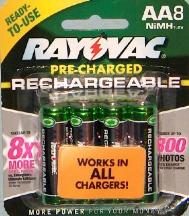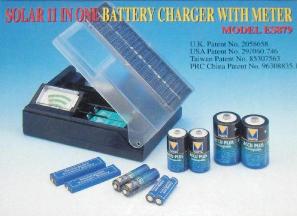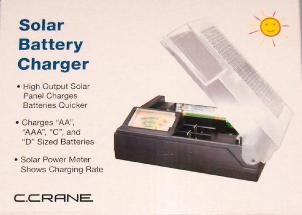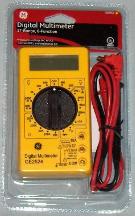

































 For several years a myth has been circulating around the internet that a 1.2 volt battery will not work in a device that specifies a 1.5 volt battery. The reason given is that the 1.2 volt battery does not have as much power as the 1.5 volt battery. Like many other myths, this myth is not true.
For several years a myth has been circulating around the internet that a 1.2 volt battery will not work in a device that specifies a 1.5 volt battery. The reason given is that the 1.2 volt battery does not have as much power as the 1.5 volt battery. Like many other myths, this myth is not true. |  |
| Eleven-in-One Battery Charger | Solar Battery Charger |
 Dimensions: 7" by 6.5" by 2.125".
Dimensions: 7" by 6.5" by 2.125". If you are interested in an optional multimeter that will provide volt and amp readings on your rechargeable batteries then you might wish to consider the GE Digital Multimeter illustrated in the picture on the right (product number 50953). It can be purchased at most WalMart stores for approximately $17 near their electrical extension cord display. Before purchasing this multimeter I visited a Radio Shack Store, an Ace Hardware Store, a True Value Hardware Store, and a Lowe’s Home Improvement Store and I carefully examined the different multimeters that were available. The GE Digital Multimeter is the one I selected. Many of the other multimeters did not have a 10A setting so they would not yield a reading for the number of amps in a rechargeable battery. The one disadvantage of this multimeter, and all the other multimeters that have a 10A setting, is that they require a 9-volt battery inside to power the multimeter. However, the 9-volt battery is advertised to power the multimeter for between 100 to 200 hours of continuous use. Since the multimeter has an "OFF" setting you will probably eventually replace the 9-volt battery due to its normal "self-discharge" rate instead of wearing the battery out using it to power the multimeter. Let me remind you that this multimeter is an optional piece of equipment and it is not needed for any reason other than to satisfy your curiosity about the voltage and amperage of your batteries. This multimeter will not measure mAH, nor will any other multimeter on the market.
If you are interested in an optional multimeter that will provide volt and amp readings on your rechargeable batteries then you might wish to consider the GE Digital Multimeter illustrated in the picture on the right (product number 50953). It can be purchased at most WalMart stores for approximately $17 near their electrical extension cord display. Before purchasing this multimeter I visited a Radio Shack Store, an Ace Hardware Store, a True Value Hardware Store, and a Lowe’s Home Improvement Store and I carefully examined the different multimeters that were available. The GE Digital Multimeter is the one I selected. Many of the other multimeters did not have a 10A setting so they would not yield a reading for the number of amps in a rechargeable battery. The one disadvantage of this multimeter, and all the other multimeters that have a 10A setting, is that they require a 9-volt battery inside to power the multimeter. However, the 9-volt battery is advertised to power the multimeter for between 100 to 200 hours of continuous use. Since the multimeter has an "OFF" setting you will probably eventually replace the 9-volt battery due to its normal "self-discharge" rate instead of wearing the battery out using it to power the multimeter. Let me remind you that this multimeter is an optional piece of equipment and it is not needed for any reason other than to satisfy your curiosity about the voltage and amperage of your batteries. This multimeter will not measure mAH, nor will any other multimeter on the market.| Battery | Rating / 167 | Minimum Recharging Time |
| Size AAA | 800 mAH / 167 = | 4.8 hours of direct sun |
| Size AAA | 850 mAH / 167 = | 5.1 hours of direct sun |
| Size AA | 850 mAH / 167 = | 5.1 hours of direct sun |
| Size AA | 1300 mAH / 167 = | 7.8 hours of direct sun |
| Size C | 1500 mAH / 167 = | 9.0 hours of direct sun |
| Size C | 2500 mAH / 167 = | 15.0 hours of direct sun |
| Size D | 2500 mAH / 167 = | 15.0 hours of direct sun |
| Size D | 3000 mAH / 167 = | 18.0 hours of direct sun |

